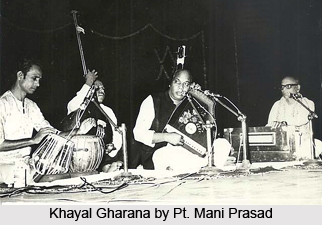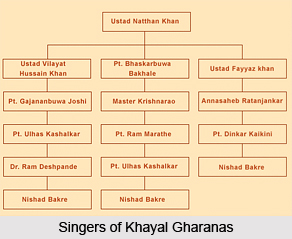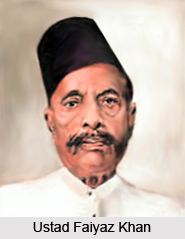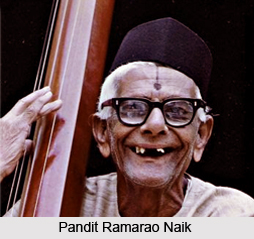 Khayal, the classical Indian music is represented by a number of stylistically different schools called the Gharanas. Every Khayal Gharana has a few distinct features, a novel facet of their own which allows one to discriminate between the different schools while enabling one to identify the varied approach. The élan of the presentation, the dash in the approach and the stylistic features of the employing of the tans, bandish and alaap makes each of the khayal gharanas matchless and aesthetic. Gwalior Gharana, Agra Gharana, Kirana Gharana, Jaipur-Atrauli Gharana, Bhendi Bazaar Gharana, Patiala Gharana and Rampur-Sahaswan Gharana are some of the important gharanas of Khayal music.
Khayal, the classical Indian music is represented by a number of stylistically different schools called the Gharanas. Every Khayal Gharana has a few distinct features, a novel facet of their own which allows one to discriminate between the different schools while enabling one to identify the varied approach. The élan of the presentation, the dash in the approach and the stylistic features of the employing of the tans, bandish and alaap makes each of the khayal gharanas matchless and aesthetic. Gwalior Gharana, Agra Gharana, Kirana Gharana, Jaipur-Atrauli Gharana, Bhendi Bazaar Gharana, Patiala Gharana and Rampur-Sahaswan Gharana are some of the important gharanas of Khayal music.
Gwalior Gharana : Gwalior gharana began its journey somewhere in the 19th century, due to the earnest endurance of two devoted individuals. Their illustrious successors, after moving to the darbar of the Lucknow maharajas, were primarily responsible for evolving the style khayal as it is heard today. Gwalior gharana is universally acknowledged as the parent of all the gharanas, due to their obvious reasons for being the oldest, the largest, and one of the most permanent of all the surviving gharanas. Their distinguishable facets make them even more celebrated in this genre. Though some of them had clung to their ancient clan of thought for the gayaki style, some of the more recent singers had made a brilliant foray by letting in non-family members, thereby creating a musical revolution.
Agra Gharana: Agra gharana is always noted as the second wonder of Agra, only after the magnificient Taj Mahal. The founders of this gharana owe much to the dhrupad-dhammar singers, as it was from them that the Agra gharana members loaned the major piriton of their skillfulness. However, borrowing ingenuity from the dhrupadi singers, the Agra gharana was hugely successful in establishing a permanent position in the musical history. And they do not undermine their teachers - Agra is the only gharana, who boldly exhibit their dhrupadic roots. The most important member of this gharana, Ghagge Khuda Naksh, has a highly curious story behind his evolving of the melodious voice. Agra gharana is still holding its place steadfastly, with a stellar line-up of singers to choose from.
 Kirana Gharana: Kirana gharana can be called unusual motley of contemporaneity and ancientness, carefully and ingenuously amalgamated to suit the audience of today. It is the only gharana that flourished entirely during the evolvement of the 20th century. Some although claim to possess roots in the dhrupadi gharana. The founding members of Kirana gharana were essentially sarangi players, which laid huge influence in their style of performance. However, it is Ustad Abdul Karim Khan, who can be called the most substantial member to have contributed whole-heartedly to make Kirana gharana stand, where it is today. He has an illustrious line-up of students and followers, who perform still today, with absolute élan and glory. Ustad Abdul Waheed Khan can be named the proponent to reintroduce the slow tempo (vilambit laya) in khayal once more, a fact that enormously attracted common man towards khayal form of classical music.
Kirana Gharana: Kirana gharana can be called unusual motley of contemporaneity and ancientness, carefully and ingenuously amalgamated to suit the audience of today. It is the only gharana that flourished entirely during the evolvement of the 20th century. Some although claim to possess roots in the dhrupadi gharana. The founding members of Kirana gharana were essentially sarangi players, which laid huge influence in their style of performance. However, it is Ustad Abdul Karim Khan, who can be called the most substantial member to have contributed whole-heartedly to make Kirana gharana stand, where it is today. He has an illustrious line-up of students and followers, who perform still today, with absolute élan and glory. Ustad Abdul Waheed Khan can be named the proponent to reintroduce the slow tempo (vilambit laya) in khayal once more, a fact that enormously attracted common man towards khayal form of classical music.
Jaipur-Atrauli Gharana: The Jaipur-Atrauli gharana is the only intellectual and pedantic school of music, that has stood its grounds with this unusual style of rendition, and quite successfully in that. They are also hewn with intricate and rhythmic patterns in khayal singing. By the sole effort of Ustad Alladiya Khan, the Jaipur-Atrauli gharana has also incorporated further facets to their style. It is known that the Ustad had lost his extremely beautiful voice after the age of 40. However, without being drowned by the setback, he additionally concentrated on the other features of singing, like swara and laya. Known to have rigorously guarded his secret of tutoring, he also had to loosen his rules to let in other exceptionally gifted young men and women to carry on his rich legacy. This school of music however, strictly goes by the book, with implementation of laya and rhythm, with elaboration, intricateness and complexity being stressed on all the three octaves.
Bhendi Bazaar Gharana: The Bhendi Bazaar gharana can be called the underdog amongst all the resplendent gharanas, with their glorious lineage and historical wonder. Although, this school did not just find things smoothly; one had to toil for it. And the man behind all the credits is Ustad Aman Ali Khan. Otherwise a man of humble and taciturn disposition, Aman Ali was possessed with an extraordinary voice quality that he tried to put to full use. He was also a talented composer with several excellent compositions, still in today`s usage. He was clever enough to pick up the nuances of khayal singing, thus popularising the diction of rhythm and tempo during the rendition of sargam-raaga elaboration.
Patiala Gharana: The Patiala gharana, fundamentally a sarangi gharana, does not need much further introduction, owing to the presence of the excelled Ustad Bade Ghulam Ali Khan. The school of music has come to a full circle with the untiring effort and tenacity in work by the Ustad.
 So much so that, everybody else tend to be overshadowed by his unsurpassed diction. The founder brothers of Patiala gharana were popular by various names, who also were responsible in introducing exceedingly fast taans. In fact, it is Patiala gharana who are the pioneers in inaugurating the feisty and colourful style of singing within khayal and the extremely conservative air of South India.
So much so that, everybody else tend to be overshadowed by his unsurpassed diction. The founder brothers of Patiala gharana were popular by various names, who also were responsible in introducing exceedingly fast taans. In fact, it is Patiala gharana who are the pioneers in inaugurating the feisty and colourful style of singing within khayal and the extremely conservative air of South India.
Rampur-Sahaswan Gharana: Owing to have been established by the grand-son of Haddu Khan from Gwalior gharana, it is but natural that Inayat Hussain Khan will possess intellect from his grandfather. However, he had later innovated it to its own stature, though some are of the faith that the school also has elements similar to the Agra school of music. However, it was only during the 20th century that the flowering occurred, with the advent of Ustad Mushtaq Hussain Khan. He gave the gharana an entirely diversified look, in spite of he himself been tutored under the influence of dhrupadi form of rendition. Mushtaq Hussain`s style is heavily resonant of the darbari and khandani style of khayals, reintroducing once more the pattern of the yesteryears. Every legend from this school is extremely adept in their technical details while recitals, making it even more exciting for the audience.
Shama Chaurasi Gharana: The Shama Chaurasi gharana originated in the Hoshiarpur area in Punjab. Later, following Partition, the gharana was relocated to Lahore. Its finest exponents were the fraternal duo, Nazakat and Salamat Ali Khan. Following Nazakat Ali`s untimely demise, the burden of continuing the tradition fell on Salamat Ali. In terms of style and voice production, their singing closely follows the Patiala gayaki of Bade Ghulam Ali Khan.
Mewati Gharana: The Mewati gharana is one style that shot into prominence during the second half of the 20th century to the popularity of its most feted singer, Pt. Jasraj. Ghagge Nazir Khan, who hailed from the Mewat region in Rajasthan (presently in Haryana), is regarded its progenitor. Ghagge passed on his legacy to two disciples, Nathulal and Chimanlal. Nathulal`s legacy passed on to his nephew, Motiram, father of Pt. Jasraj. Though they share the same musical inheritance, their technical approaches and vocal gifts are on vastly dissimilar planes. Of the three, Jasraj`s style is highly ornate and lyrically polished. He pays painstaking attention to the words in the bandish - their meaning and poetic content - and arouses their dominant moods using the framework of the raga. Jasraj is also an excellent singer of Vaishnava bhajans and slokas. He, more than anyone, brought the haveli sangeet sung in many
 Vaishnava temples in North India to public attention through his resonant voice, without any assistance.
Vaishnava temples in North India to public attention through his resonant voice, without any assistance.
Delhi Gharana: The Delhi gharana was founded by the singer and composer Miyan Achpal in the 19th century. The legendary Tanras Khan was tutored by him. In the 20th century the Delhi gharana is represented by three singers, who are all related by blood - the late Ustad Chand Khan, his nephew, the late Nasir Ahmed Kahn and his contemporary exponent, Ustad Iqbal Ahmed Khan. Ahmed Khan`s lyrical and agile khayal renditions and his dazzling taans made him quite a force, until his ill-timed demise. Today, Iqbal Ahmed Khan continues the gharana traditions.
Benaras Gharana: Benaras has produced some of the greatest tabla maestros, shehnai and sarangi players of the 20th century, as it ahs the finest exponents of the Poorab-ang thumri. Yet through the efforts of Bade Ramdas Misra, a singer in the court of Nepal, the Benaras khayal gharana came into being. The style shot into prominence owing to the well-deserved popularity of the duo, Pt. Rajan and Pt. Sajan Misra. Though originally from a family of sarangi players (the sarangi wizard, Pt. Gopal Misra was their uncle), the Misra brothers have gone on to absorb the best features from other idioms and styles and thus enriched their stock.




